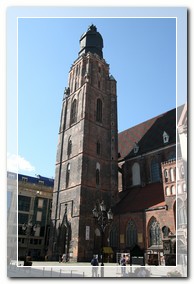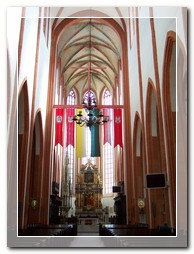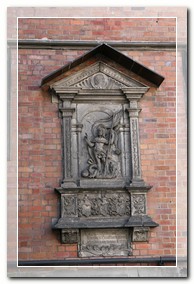


 ittle houses Jaś and
Małgosia, standing in the north-western part of the market, seem even
smaller compared to the giant standing behind them, the XIV-century
saint Elizabeth of Hungary Gothic basilica, also called Elizabethan
Parish church or from it's later function the Garrison Church,
possessing the highest tower in Wroclaw — it is about 90 m high today,
however when in XV century the building was finished, together with it's
50 meters helmet it had over 130 meters of height and it was not only
the highest tower on Silesia, but one of the highest in Europe. It was
supposed to fulfill the ambitions of Wroclaw's patriciate and rich
townspeople, compeering in height with the Episcopal Cathedral of saint
John.
ittle houses Jaś and
Małgosia, standing in the north-western part of the market, seem even
smaller compared to the giant standing behind them, the XIV-century
saint Elizabeth of Hungary Gothic basilica, also called Elizabethan
Parish church or from it's later function the Garrison Church,
possessing the highest tower in Wroclaw — it is about 90 m high today,
however when in XV century the building was finished, together with it's
50 meters helmet it had over 130 meters of height and it was not only
the highest tower on Silesia, but one of the highest in Europe. It was
supposed to fulfill the ambitions of Wroclaw's patriciate and rich
townspeople, compeering in height with the Episcopal Cathedral of saint
John.
This church was originally Catholic, however in 1525 it passed in the rules of Protestants. The legend says that a clever Protestant patrician, Heinrich von Rybisch had won him in cards from Erharda Scultetusa, the master of Crusaders from saint Matthias, risking the loss of the marvelous beauty of the gold chain. In four years after taking over the church by Protestants, the helmet - crooked from the beginning, too heavy, because weighing well over 25 tones - collapsed from the tower on the nearby tenement number 22. Catholics claimed that it was a punishment for taking their church. Protestants on the other hand announced that it was a miracle, because in the result of the building catastrophe only one kitten died, which was on top of the roof in that moment. It was told that people crossing by saw angels raising the declining part of the tower, what the bas-relief illustrates on the facade of the church.
Wonders multiplied around the saint Elisabeth's Parish church. One could once see a wooden crucifix, on which true human hair grew (allegedly) in the wayside shrine near the church, which burnt in 1848!
The rich townsmen considered as point of honor to buy the next
elements of the equipment of the church, so it's interior decorations  became more and more
rich. Special attention should be paid to an unusual, 15 meters high,
late-gothic sacramentary carved in stone, finished in 1455. However,
once almost 47 mediaeval altars existed here. Acolytes, who lived in the
nearby Jaś and Małgosia, looked after them. As time passed a huge,
counting above 370 arts, collection of beautifully carved in epitaphs
was collected. The Parish church could also be proud of it's richly
adorned organs with 91 voices, made by Michaela and Benjamin Englers,
creators of organs famous in the whole Europe. Unfortunately the organs
were burnt in 1976, but the recordings of their sounds and pictures were
saved, thanks to what one could begin an ambitious project of their
reconstruction, which lasts till today.
became more and more
rich. Special attention should be paid to an unusual, 15 meters high,
late-gothic sacramentary carved in stone, finished in 1455. However,
once almost 47 mediaeval altars existed here. Acolytes, who lived in the
nearby Jaś and Małgosia, looked after them. As time passed a huge,
counting above 370 arts, collection of beautifully carved in epitaphs
was collected. The Parish church could also be proud of it's richly
adorned organs with 91 voices, made by Michaela and Benjamin Englers,
creators of organs famous in the whole Europe. Unfortunately the organs
were burnt in 1976, but the recordings of their sounds and pictures were
saved, thanks to what one could begin an ambitious project of their
reconstruction, which lasts till today.
If we are in a good shape and do not fear stairs, let's enter the
scenic terrace on the tower and admire the old city from the bird's eye
view.
 It is also good to pay the attention on the plates of the path
leading from the market to the entry to the Parish church - the graves
of 23 participants of a revolt of the municipal pleb in 1418 lie beneath
it, who killed several councilors and the mayor. The path was arranged
so that their graves were continually trampled by passers-by and their
souls did not experience quiet after death. According to a legend, the
spirit of a dishonest fabric saleswoman got up every night from this
cemetery as a punishment for her frauds and from midnight to one o'clock
she measured canvas in the nearby cloth halls. The ghost stopped
intruding it's former stall, when the corpse of the dishonest woman were
dig out and burnt. This legend was surely an inspiration for the "Danse
macabre" ballad by Johan Wolfgang Goethe, who in 1790 spent two months
in Wroclaw and lived near the saint Elisabeth church.
It is also good to pay the attention on the plates of the path
leading from the market to the entry to the Parish church - the graves
of 23 participants of a revolt of the municipal pleb in 1418 lie beneath
it, who killed several councilors and the mayor. The path was arranged
so that their graves were continually trampled by passers-by and their
souls did not experience quiet after death. According to a legend, the
spirit of a dishonest fabric saleswoman got up every night from this
cemetery as a punishment for her frauds and from midnight to one o'clock
she measured canvas in the nearby cloth halls. The ghost stopped
intruding it's former stall, when the corpse of the dishonest woman were
dig out and burnt. This legend was surely an inspiration for the "Danse
macabre" ballad by Johan Wolfgang Goethe, who in 1790 spent two months
in Wroclaw and lived near the saint Elisabeth church.






